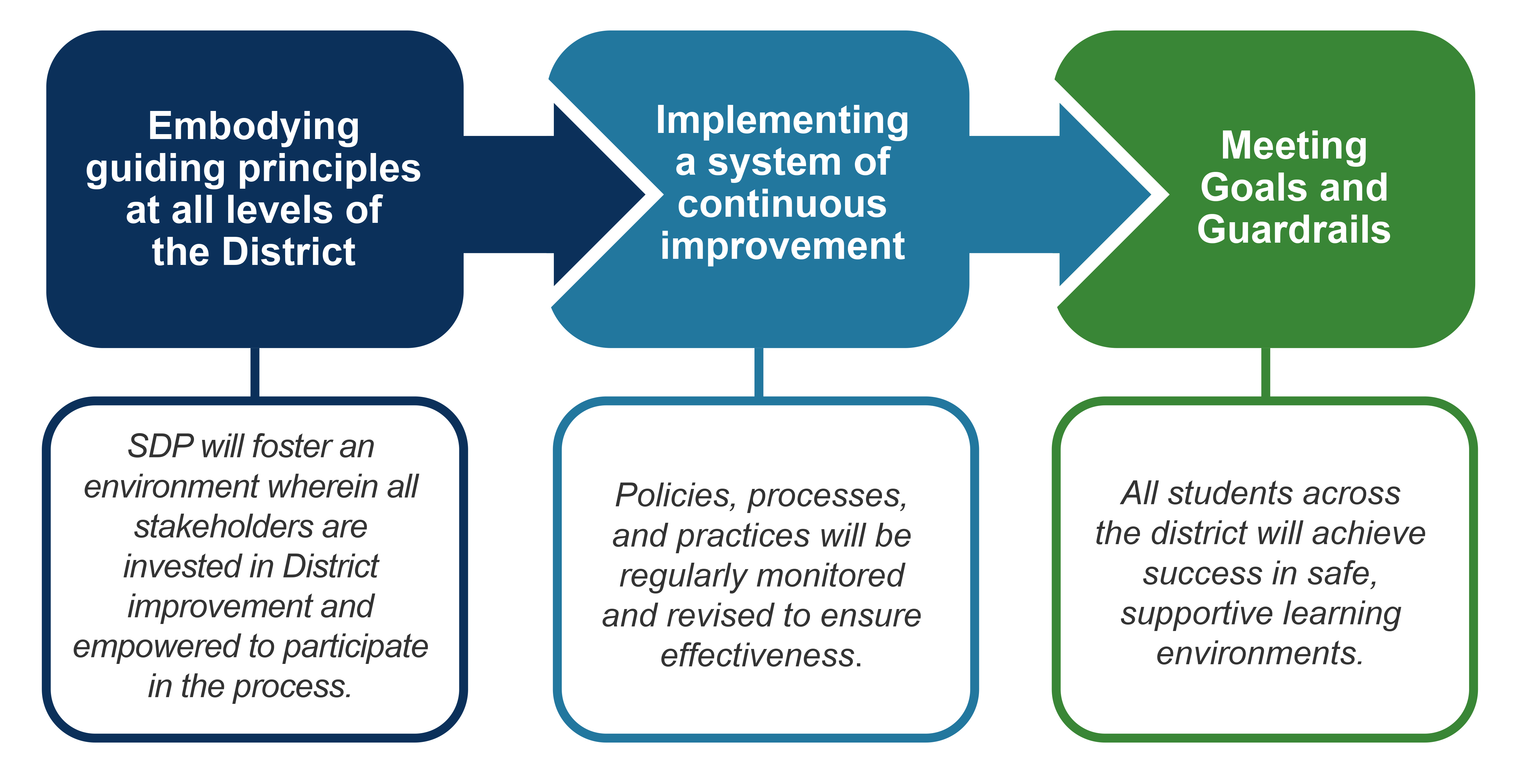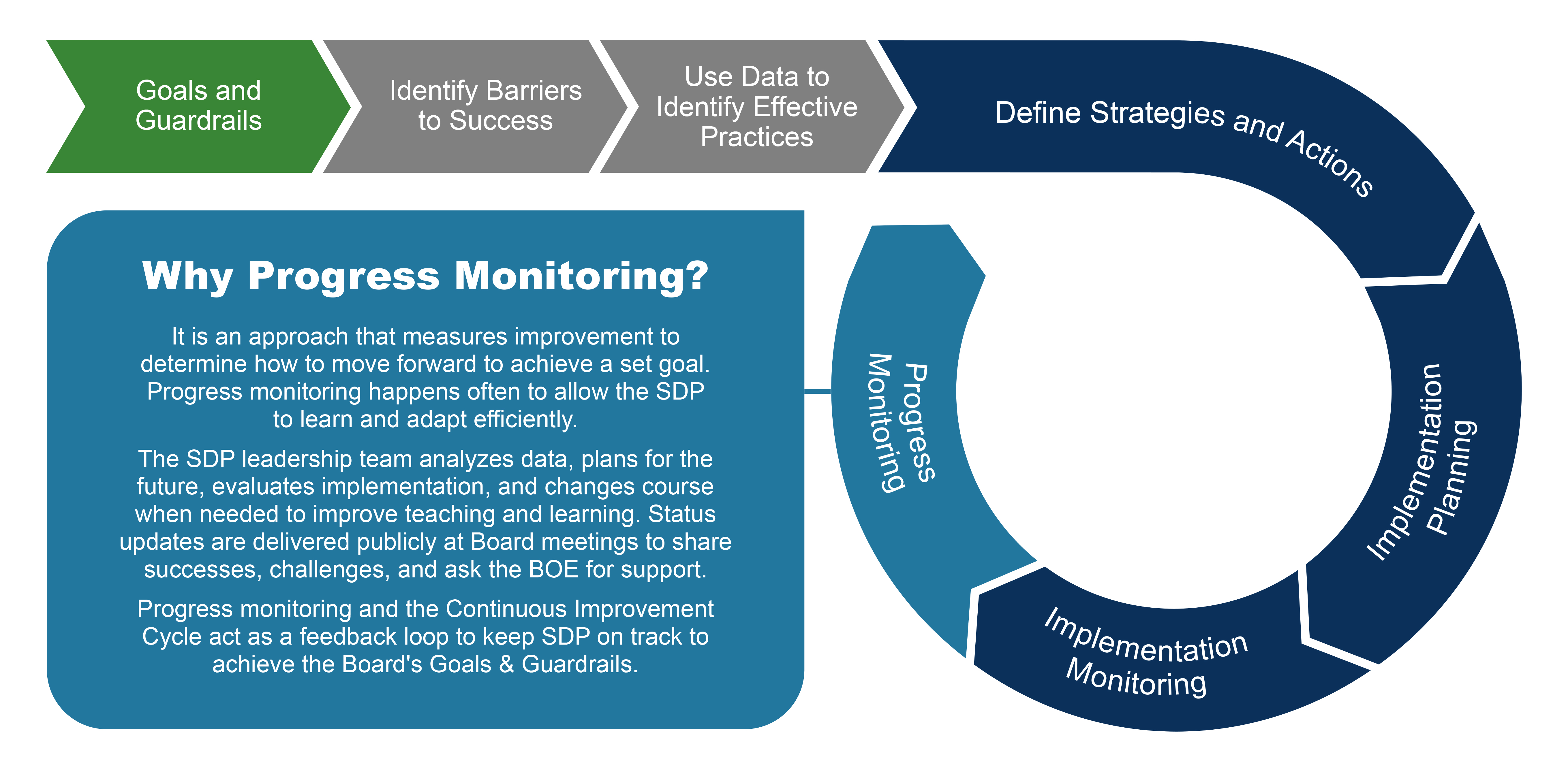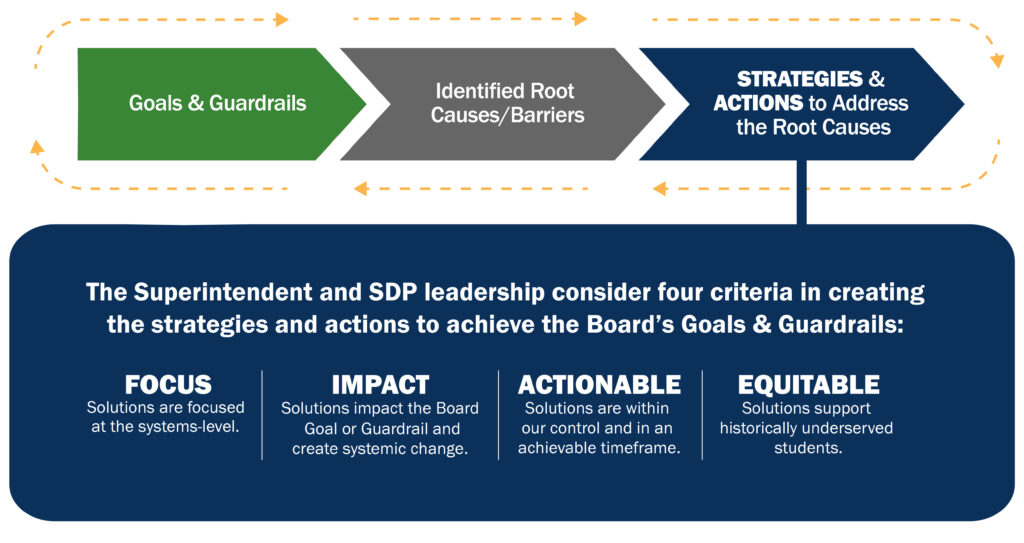The Board of Education’s vision is for all School District of Philadelphia students to thrive, succeed, and lead in a global society. This drives the mission of the SDP to provide an excellent public school education and ensure all children graduate from high school ready to succeed, fully engaged as a citizen of our world. We can achieve these by working together and committing to the changes needed to provide our students, educators, and leaders with the necessary opportunities and resources.
We approach this work with urgency, a focus on equity, and with a new method of problem solving and implementing solutions. But it won’t happen overnight. We are setting clear expectations and rigorously monitoring our progress. We are committed to taking swift action driven by data, community input, and proven strategies.
To fulfill this vision, the Board of Education (BOE) has established Goals and Guardrails that outline what our students must know and be able to accomplish, and describe conditions needed in each school to empower all students to succeed in and beyond the classroom. The ultimate goal is to ensure that every student performs at or above grade level at schools that are safe and welcoming, antiracist, and well-rounded. As a first step, the Board has outlined achievement goals for the next five years. These clear priorities ensure coordinated efforts across the district to drive improved student success.
Goals
65% of 3rd-8th grade students will be proficient on the state ELA assessment by August 2025. In August 2019, 35.7% of students were proficient.
Data and Research
62% of 3rd grade students will be proficient on the state ELA assessment by August 2025. In August 2019, 32.5% of students were proficient.
Data and Research
52% of 3rd-8th grade students will be proficient on the state math assessment by August 2025. In August 2019, 21.5% of students were proficient.
Data and Research
By August 2025, 52% of high school students at the end of 11th grade will be proficient on all three state high school assessments (Algebra, Literature, and Biology). 22.2% of students were proficient in August 2019.
Data and Research
80% of Career and Technical Education (CTE) students will pass an industry standards-based competency assessment by the end of 12th grade. In August 2019, 49.9% of students passed.
Data and Research
Guardrails
Every school will be a safe, welcoming, and healthy place for all students, staff, and community to learn. Our schools will be physically safe and clean with an inclusive environment. Students will have access to social, emotional, and mental health supports.
Data and Research
Students will have a well-rounded education with opportunities in the arts and athletics.
Data and Research
Parents and guardians will be encouraged to be partners in their student’s school community.
Data and Research
Students’ potential and achievement will not be limited by practices that maintain systemic racism.
Data and Research
To learn more about the District’s data and research related to these goals and guardrails click here.
To achieve the Board’s Goals and Guardrails, we have changed our approach to identifying barriers to success, implementing targeted solutions, and measuring progress. Our new approach is guided by the following principles, which allow us to achieve our ultimate goals for student opportunities and outcomes:
Anchor on a shared purpose and vision
Maintain a growth mindset with a focus on the long-term goals
Lead by example through a commitment to improvement
Use high quality data to proactively address challenges
Align monitoring and decision making processes and structures
By adopting these guiding principles, the Board of Education, district and school leaders, teachers, families, students, and community partners will work together to address challenges and hold each other accountable. Our approach is rooted in continuous improvement and allows SDP to quickly adapt, improve, and measure progress. This will allow us to meet the Goals and Guardrails.
SDP drives improvement by:
Continuous Improvement Cycle
Continuous improvement uses data to understand the root of a problem, identify proven solutions to that challenge, and monitor the implementation and progress of those solutions. It is a smart, effective approach to making improvements in the District. This cycle is ongoing and requires the teamwork of the Board, Superintendent, and SDP leadership, as well as school leaders, teachers, families, students, and community partners. Monthly at Board of Education meetings, the community will publicly monitor progress towards the Goals and Guardrails.
To learn more about how we measure each school’s progress click here.
Our Current Strategies and Actions
Through this approach, School District leaders have identified strategies and actions that target root causes that serve as barriers to meeting the Board’s Goals and Guardrails. These strategies are implemented with focus and rigor, and build on the work of the District’s previous Action Plan to further accelerate student achievement.
During the school year 2021-2022, the Superintendent and SDP leadership are implementing and measuring progress on the following three (3) strategies and five (5) actions. Each action has an implementation plan to serve as a guide and inform investments.
Implement an academic framework that includes standards-aligned curriculum.
Actions 1.1
Implement new, culturally and linguistically inclusive curriculum and instructional guidance for K-12 literacy to support grade-level instruction for ELs and students with IEPs.
Actions 1.2
Implement new culturally and linguistically inclusive curriculum and instructional guidance for K-12 math to support grade-level instruction for ELs and students with IEPs.
Implement the Multi-Tiered System of Supports (MTSS) Framework.
Actions 2.1
Improve the implementation of Multi-Tiered System of Supports (MTSS) by providing professional learning and supports for school leaders and staff to better understand and utilize the framework. MTSS is a standards-aligned, comprehensive school improvement framework for enhancing academic, behavioral and social-emotional outcomes for all students.
Develop leaders and teachers through implementation of evidence-based professional learning and common planning time.
Actions 3.1
Redesign professional learning. Professional learning provides school leaders and teachers time to learn new skills in order to improve instruction. Professional learning cycles are ongoing, “nested” cycles of professional development, practice, feedback, and reflection.
Actions 3.2
Implement Common Planning Time in all schools. Common Planning time is a regularly scheduled, structured time where school leaders and teachers collaborate. Common Planning Time allows school leaders and teachers to work together to improve their own teaching and improve learning for all students.
Develop and implement an equity framework and expand access to high quality opportunities for all students.
Actions 4.1
Fully adopt and operationalize the Equity Framework complete with lens. The Equity Framework guides the District’s identification and eradication of oppressive policies and practices. A key part of the Framework is the equity lens, which is a tool to guide all equity-centered decision-making in SDP.
Actions 4.2
Provide all high school students access to and information about high quality opportunities and experiences. This includes regularly collecting data about student access to academic opportunities, arts and co-curriculars, and safe and supportive learning environments to promote equitable opportunities for our most marginalized students.
Actions 4.3
Establish processes to expose students and families to career-related academic pathways and the school selection process beginning in the early elementary grades. Processes will be culturally responsive, linguistically inclusive, and accessible so that all students are supported in determining their career goals and identifying the schools and campuses that best fit their interests and needs.
As progress continues to be made, these strategies and actions will focus and guide our work in achieving the Board’s Goals and Guardrails to improve student outcomes and opportunities.
Through these actions, the Superintendent and SDP Leadership will:
- Ensure all schools and teachers have access to high quality, evidence-based inputs which include universal screeners to assess learning, new curriculum and instructional guides, and school-wide climate programming.
- Establish professional learning cycles and respect common planning time, which build the capacity of school leaders and teachers to understand and implement our school-wide inputs and deliver grade-level standards-based instruction
- Prioritize and build capacity for school leaders to implement monthly MTSS Problem-Solving Meetings in their buildings.
So that school leaders and teachers can…
- Ensure every student will engage in culturally appropriate, grade-level, standards-based instruction in a safe and welcoming learning environment.
- Develop their ability to implement our high-quality grade level instruction and school-wide climate programs to address every student’s needs, especially the needs of historically marginalized groups.
- Review progress on implementing evidence-based strategies, identify school-wide trends, address and solve areas of concern, and celebrate the successes of every student.
And students can expect to...
- Receive rigorous, engaging, and culturally-relevant instruction
- Learn in safe, supportive, and antiracist environments.
- Thrive, succeed, and lead in a global society.
As the first step in our continuous improvement efforts, the Superintendent and SDP leadership are currently implementing and measuring progress on three (3) strategies and five (5) actions. These are in various stages of implementation or implementation planning phases. Each strategy and action is monitored in their implementation and their impact on the Goals and Guardrails. Part of continuous improvement is reviewing data regularly. Each Goal will be publicly monitored three times a year and each Guardrail will be publicly reported on once a year at Board meetings.
Click here for the Progress Monitoring Dashboard to track ongoing progress towards our goals.
Our Implementation Progress
Once actions have been identified to address existing challenges, SDP leadership works with Assistant Superintendents, principals, and teachers to implement them. This happens in four primary stages over the course of several school years.
Implementation Stages

- Implementation Planning: Develop vision, plan investments, and prepare for implementation
- Initial Implementation: Use data to improve implementation and address challenges
- Full Implementation: Scale effective implementation strategies and monitor student outcomes
- Sustained Implementation: Support continued delivery of services
Track where each action is in its implementation progress below.
Action 1.1
Implement new culturally linguistically inclusive curriculum and instructional guidance for K-8 literacy to support grade-level instruction for ELs and students with disabilities.

View image larger
Action 1.2
Implement new culturally linguistically inclusive curriculum and instructional guidance for K-8 math to support grade-level instruction for ELs and students with disabilities.

View image larger
Action 2.1
Improve the implementation of Multi-Tiered System of Supports (MTSS) by providing professional learning and supports for school leaders and staff to better understand and utilize the framework.

View image larger
Action 4.1
Adopt and operationalize the Equity Framework complete with lens.

View image larger
Action 4.2
Provide all high school students access to high quality opportunities and experiences.

View image larger
Action 4.3
Establish processes to expose students and families to academic pathways and school selection.

View image larger
Our Progress Monitoring
The Progress Monitoring process ensures that the Board of Education and all members of the community can see the impacts of these efforts. Progress monitoring takes place at the monthly Board of Education action meetings. The Progress Monitoring Dashboard presents regularly reported data tracking movement towards our goals.
Click here for the monthly progress monitoring calendar
Last modified: October 15, 2024










